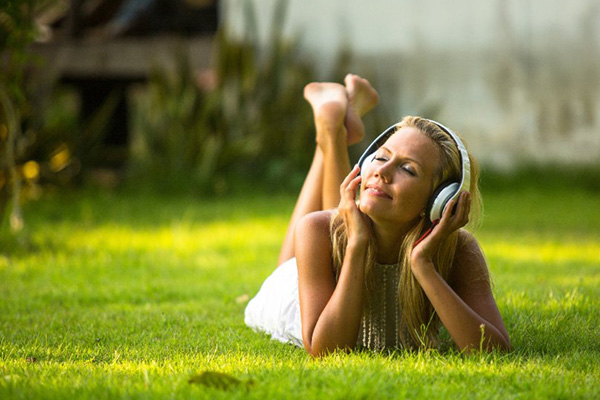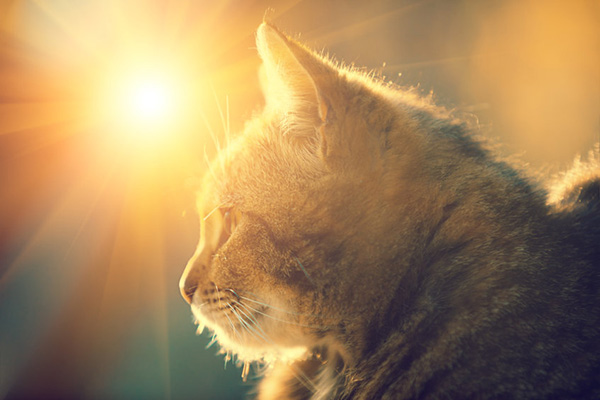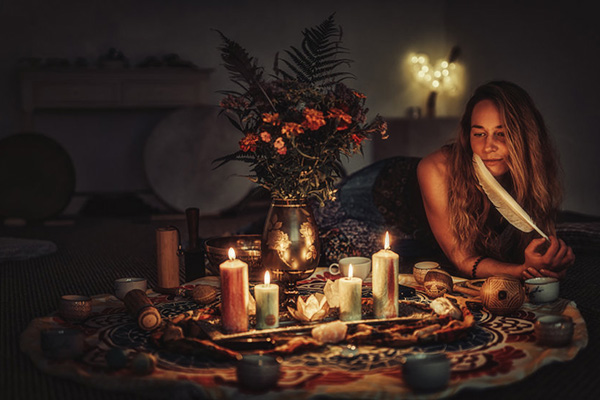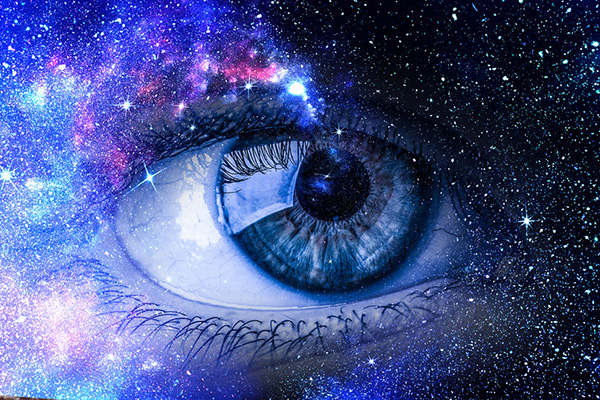Two Easy Ways To Start Meditating!
 Meditation is the go-to spiritual practice for millions of people all over the world. Not only does it offer incredible benefits for clarity of mind and overall well-being, it is also a powerful self-care tool to help us navigate our lives for our highest good.
Meditation is the go-to spiritual practice for millions of people all over the world. Not only does it offer incredible benefits for clarity of mind and overall well-being, it is also a powerful self-care tool to help us navigate our lives for our highest good.
But, for newbies getting started with a meditation practice can be challenging at first. I often hear people say, “I can’t meditate, I fall asleep every time,” or “Oh, I tried meditating, but I got too distracted, because I can’t properly clear my mind.”
If this sounds like you, please know that many beginners struggle with the notion that in order to ‘properly’ meditate, one must sit motionless, eyes closed, and clear your mind of all thoughts, and that an inability to do so means that they’ve failed to meditate, or that meditation is ‘not for them.’
The truth is meditation is called a ‘practice’ because it really does take practice to develop and master. But that does not mean it has to be complicated or difficult. Anyone can learn to meditate. To develop your meditation skills more easily, I suggest you begin with a meditation routine in one of two ways: guided meditation, or nature meditation.
Guided Meditation
We have ease of access to guided meditations these days due to convenient advances in digital technology. Gone are the days of having to attend a meditation class in person, or struggling with audio cassette tapes! These days high quality guided meditations can be instantly downloaded or streamed from various websites, apps, and social media platforms. All you need is your smartphone, and a pair of earphones or a headset.
Connecting With Your Pets Energetically
 I am the proud pet mama of two cats who could not be more different from one another. Francis is fearless. She’s an agile huntress who is always catching dragonflies and darting around the house. Merlin on the other hand, is slow and lazy. More content to make friends with mice and munch on leaves, he is a cat who just loves to love.
I am the proud pet mama of two cats who could not be more different from one another. Francis is fearless. She’s an agile huntress who is always catching dragonflies and darting around the house. Merlin on the other hand, is slow and lazy. More content to make friends with mice and munch on leaves, he is a cat who just loves to love.
There was a time when Merlin went missing for some time. I was devastated! At first, I simply couldn’t believe it. We had just moved a considerable distance, so he was not at all familiar with the area and his new environment. He is an indoor cat that is afraid of grass and any kind of large moving objects (like boughs of trees moving in the wind). I was terrified for him.
After many days of fruitless, I was beginning to lose hope. I had put the word out with the local animal control and missing pet boards. My partner and I knocked on doors and wandered the neighbourhood nightly, calling out his name, but there was no sign of him at all.
In my heart, I knew Merlin was still out there. As the second week of his absence ended, I just had to try something new. I was willing to try anything at this point!
So, I consulted the Tarot. I asked where I might find him, or when he would come home, but my intensely clouded emotions made a clear, sensible reading impossible. Reading for oneself is generally not a good idea, much less when you are as distraught as I was at the time. The Tarot is also not the ideal psychic tool for these kinds of questions.
Then I began researching energetic methods for finding a lost a pet. This is when I discovered an energy meditation known as the ‘golden thread,’ or the ‘golden cord.’ It is a simple visualization technique for connecting energetically with a pet.
Ritual In A Modern Spiritual Lifestyle
 Rituals, rites and ceremonies are the oldest forms of spiritual practice and essential aspects of all religions and belief systems. A ritual is a meaningful or symbolic action or series of actions that has a standardized format or sequence and can therefore be repeated in exactly the same way by individuals, groups or even communities.
Rituals, rites and ceremonies are the oldest forms of spiritual practice and essential aspects of all religions and belief systems. A ritual is a meaningful or symbolic action or series of actions that has a standardized format or sequence and can therefore be repeated in exactly the same way by individuals, groups or even communities.
The metaphysical energy generated when we focus our intent using symbols, tokens and metaphoric activities during a ritual that has special meaning for us personally can be highly transformative! Whether you practice ritual in a group or solo, it can supercharge your manifesting ability and aid in any mental, physical, emotional, and spiritual healing processes you may be going through.
When some people hear the word ‘ritual,’ they tend to imagine darkened, smoke-filled rooms with mysterious people in long robes, chanting strange refrains perhaps, all choreographed with everyone knowing their roles. I’m sure there are people who practice rituals in this way and elements like incense and chanting can indeed be party of a rite or ceremony. But a ritual can also be more simply crafted in a way to fit into a modern lifestyle and everyday spiritual practice.
In my own practice, I created a little ‘altar’ for myself. A small sacred space where I have placed a few candles, some incense, crystals, feathers and a few other symbolic tokens which hold special meaning for me. I also added a picture of my mother and a statue of an angel given to me when my grandpa passed away. In this way I created a sacred space that has deep meaning for me personally and brings me into a spiritual mindset.
You don’t need to have a lot of room for this in your home. So, you can even create a small sacred space for yourself on the corner of a dresser or table top. As my practice has evolved, I now find that any spare surface or quiet corner in the places where I have lived can become a nook for little spiritual treasures that I find during my adventures. Once you start creating a sacred space, the Universe will send you little gifts to help you along.
Eye Gazing As A Spiritual Practice
 Eye gazing is a powerful, ancient practice in which two people engage in a shared meditation practice during which eye contact is maintained for an extended period of time. Eye gazing is usually done for about ten minutes at a time, although it can certainly be any duration preferred.
Eye gazing is a powerful, ancient practice in which two people engage in a shared meditation practice during which eye contact is maintained for an extended period of time. Eye gazing is usually done for about ten minutes at a time, although it can certainly be any duration preferred.
Eye gazing can be used to access past life information, promote healing, connect to your higher self, guides, or angels, and almost anything else you can imagine. The eyes are the windows to our soul, and our soul is the singularity that connects us to everything else: the Universe, Source, God, the Divine. Eye gazing is also a profound manifesting tool we can use to further develop our ‘spiritual muscles,’ so to speak.
Before you include eye gazing in your spiritual practice, I recommend you read my previous blog on the essentials of eye gazing. Once you are more familiar with the basics, you can also apply the following guidelines to your eye gazing practice.
To use eye gazing for a specific purpose, you must set a clear intention beforehand, and then hold that intention throughout the gaze. You hold an intention by simply keeping a gentle awareness in the back of your mind that what you are seeing during the gaze is relevant to your intention, and trusting that whatever comes forward is always relevant.
It’s important not to simultaneously hold any expectations about what you’re going to see, or to resist anything that comes up spontaneously, just because you don’t immediately see its relevance or connection to your intention. Keep an open mind and be flexible and accepting in the flow of your gazing experience.
If you’re gazing alone, sit comfortably in front of a mirror, take a few centering breaths, and then state your intention out loud. I prefer to speak aloud in my spiritual practice whenever possible, as words are energy forms and therefore add a ‘weight’ to our prayer requests, intentions, and affirmations. State your intention out loud and ask Spirit to provide insight around this intention. Use language that feels right for you.
How To Set Intentions That Manifest
 Not long ago, I was going through some storage boxes and out fell a little scrap of paper. Curious, I picked it up, unfolded it and read the words I had written over a year earlier.
Not long ago, I was going through some storage boxes and out fell a little scrap of paper. Curious, I picked it up, unfolded it and read the words I had written over a year earlier.
Now, I do not remember writing this little note, or saving it for that matter. But what I found grabbed my attention and pulled me immediately into the present moment.
It was a wish list. I had written things like, “do fulfilling work that feeds my soul,” and “a home with by the ocean, mountains and forest.” As I read through the items on this list, I realized that all of them had meanwhile become a reality in my life. I was amazed, and filled with gratitude!
Like most people, I also too often forget to take stock and honor moments of gratitude for the many blessings in my life.
While this wish list shook me back into gratitude, it also got me thinking about something else. The power of intention.
I always say that life is like driving – you need to look where you want your car to go. With the general busy-ness of life getting in the way, it can be challenging to stay focused on where we want to be versus where we are now.
I have found the following three strategies help to bring me back into full presence and awareness in the current moment, as well as setting intentions like a ‘map’ of where I want to be headed.
Envision The Broad Strokes
It is vital to understand that universal energies seek to help us manifest that which is our highest and best good. With this concept as our framework, we allow these energies to work within our lives in ways we may never have expected.
Conscious Conflict Resolution
 Dealing with tension and conflict is one of the most challenging dynamics in friendships and relationships. We have all found ourselves in a shouting match with someone we love, or concluding an argument feeling awful and unresolved.
Dealing with tension and conflict is one of the most challenging dynamics in friendships and relationships. We have all found ourselves in a shouting match with someone we love, or concluding an argument feeling awful and unresolved.
Getting to the root of an issue without all the drama sometimes feels impossible. But conflict resolution is a skill, and one that can be honed with practice and patience.
The following strategies are helpful in shifting from overreaction to consciously seeking resolution when faced with difficult conversations or conflict scenarios.
Pause For Self-Awareness
Pause and identify what you are feeling. Step back from the feeling and merely observe it, as well as any thoughts that come along with the feeling.
Recognize that ‘you’ are not the feeling; it is a simply a sensation you are experiencing. Often people will say they are ‘angry,’ but words are powerful and this indicates that you have identified with the anger. You are actually saying: ‘I am anger.’
Do not choose to ‘be anger.’ You are merely experiencing anger. Shifting this mindset can help to separate your rational mind, from the emotional sensation of anger (or hurt, or whatever feeling you may be experiencing).
Once you are able to observe your emotions and thoughts in this way, it becomes much easier to avoid reacting from them. By not reacting, you give yourself the opportunity to think about your response first, and consciously choose your course of action.
How To Avoid Empath Ego-Traps
 Being an empowered empath is a wonderful gift and blessing. But the empath ‘label’ can also become problematic when it is misconceived by some as meaning more than it truly signifies.
Being an empowered empath is a wonderful gift and blessing. But the empath ‘label’ can also become problematic when it is misconceived by some as meaning more than it truly signifies.
There are very common ego-traps that some empaths and highly sensitive people get hung up on with regards their empathic experiences. These ego-traps can be very counterproductive, as it may actually be holding them back from meaningful personal growth and progressing our spiritual path.
These ego traps are easy to get wrapped up in, but they are not a sign of weakness or failure. The experience of being an empath is often intense and confusing. These ego-traps offer lessons for us that often go hand-in-hand with life as an empath.
Some of the typical empath ego-traps are as follows:
Empaths Always Know Best
Assuming we are always right about how we ‘read’ a situation or person, or needing to save everyone and be everybody’s ‘therapist.’ We may have a good read that something is amiss, or that someone is upset, but its unwise to assume we always know exactly why.
Often empaths will feel something from someone and decide for themselves why that person is feeling that way. This is a good way to create conflict and tension in relationships! Instead of assuming, rather ask.
And if the person doesn’t want to talk about it, try assuming it is not about you, and that maybe you have no idea what is really upsetting them. Start there. Give the person space and do not make it about you. Continue reading
